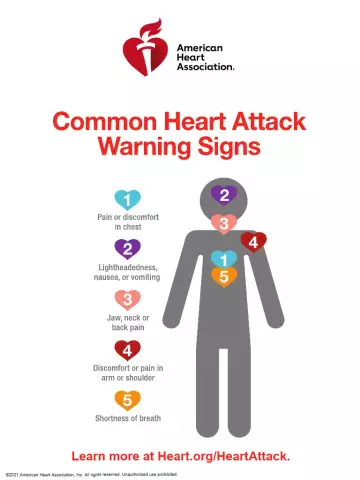- Author Rachel Wainwright [email protected].
- Public 2023-12-15 07:39.
- Last modified 2025-11-02 20:14.
First aid for shock
Shock is a pathological reaction of the body that occurs in response to irritation caused by a traumatic factor (or a combination of factors) of excessive force, which the body is unable to cope with. Shock is a violation of vital body functions and is a direct threat to human life.

Types of shock
A state of shock can be caused by various factors, both external (trauma) and internal (disease). Depending on the damaging factor, there are several types of shock, the main of which are the following:
- Cardiogenic - develops as a result of a violation of cardiac activity. It can develop with myocardial infarction, angina attack, arrhythmias, etc.;
- Hypovolemic - associated with a critical decrease in the volume of blood circulating in the bloodstream. It is most often caused by massive blood loss, less often by severe dehydration;
- Traumatic - caused by trauma, accompanied by significant damage to organs and tissues. Such an injury can be multiple or simply severe fractures (fracture of the pelvis, spine), gunshot wounds, craniocerebral trauma, concomitant injury, etc.;
- Infectious-toxic - caused by the ingestion of an excessive amount of toxins produced by pathogenic microorganisms (bacteria and viruses);
- Septic - associated with a severe infectious inflammatory process, as a result of which tissue hypoxia develops - an insufficient supply of oxygen to tissues, which leads to a disruption of the function of many vital organs at once, the so-called multiple organ failure develops;
- Anaphylactic is an extreme, immediate allergic reaction, usually in response to a drug. Less commonly caused by food allergies or poison ingestion (such as insect bites).
Some researchers also highlight psychogenic shock, which occurs as a result of severe mental shock (grief, horror, despair, etc.).
Most often, in practice, one has to deal with cardiogenic and traumatic shock, less often with psychogenic. Shock can also be combined - for example, a shock state with extensive burns is caused by several factors at once.
There are other classifications, which we will not dwell on, since they have nothing to do with first aid. We only note that they often speak of pain shock. Traumatic shock most often falls under this definition, although intense pain can be caused not only by trauma, but also by a heart attack (cardiogenic shock with angina pectoris), and a penetrating injury (hypovolemic shock), and acute pathology of internal organs (ulcer perforation, renal colic, intestinal obstruction, etc.).
The degree of shock and their signs. Shock Index
For the correct provision of first aid for shock, its degree should be determined. In total, four degrees are distinguished in a state of shock, but since the latter is terminal, i.e. in fact, the death of the body, usually talk about three:
- I degree - compensation. The victim is conscious, adequate, makes contact, reactions are inhibited, or, conversely, overexcitation is noted (may shout, swear). The face is pale or red. The upper pressure indicator (systolic pressure) is above 90 mm Hg, pulse is 90-100 beats / min. The prognosis at this stage is favorable, all phenomena are reversible, and first aid measures may be sufficient to bring the victim back to normal. However, a physical examination is necessary in order not to be mistaken in determining the degree of shock;
- II degree - subcompensation. The victim is conscious, shallow breathing, pulse quickens up to 140 beats / min, weak, systolic pressure 80-90 mm Hg. There is pallor of the skin, cold sweat, chills. Reactions are inhibited, but contact is maintained, the person answers questions, speech is quiet and weak. This is a dangerous stage of shock that requires medical attention, since with an unfavorable course it can develop into the next stage;
- III degree - decompensation. The victim can be both conscious and unconscious. He is inactive, if he is conscious, he answers questions in a whisper, slowly, in monosyllables, or does not answer at all. The skin is pale, sometimes with a bluish tinge, covered with cold sweat, breathing is frequent, shallow. Systolic pressure 70 mm Hg and below. The pulse is very weak filling, speeded up - it can reach up to 180 beats / min, is determined only on the large arteries (carotid or femoral). At this stage, the patient needs emergency medical care and resuscitation measures in a hospital setting;
- IV degree - irreversible. A terminal condition in which the patient is unconscious, the skin is white or gray, sometimes marbling (uneven tone associated with impaired blood circulation in the capillaries), the lips and nasolabial triangle are blue, the upper pressure is less than 50 mm Hg. or not at all, the pulse is defined as threadlike and only on large arteries, or absent. Breathing is shallow, uneven, pupils are dilated, reflexes are absent. At this stage, the prognosis is poor even with medical attention. Despite this, first aid for grade IV shock, as well as medical, should still be provided, since while a person is alive there is still a chance of recovery, albeit small, still exists.
It is not always possible to determine the degree of shock by external signs, therefore, for convenience, doctors use the so-called Algover index, or shock index. It is not difficult to calculate it if you have a tonometer. The Algover index is determined by the ratio of the pulse to the upper (systolic) blood pressure. For example, if the pulse is 80 beats / min, and the systolic blood pressure is 120 mm Hg, then the Algover index is determined as 80: 120 = 0.66. The normal indicator is considered to be 0.5 - 0.7, indicator 1 is a shock of the first degree, indicator 1.5 - shock of the second degree, indicator 2 - shock of the third degree. Shock in the IV degree usually does not cause difficulties in determining.

First aid for shock
A state of shock is a serious health hazard, and it is very difficult for a non-specialist to correctly assess this hazard. Therefore, if the victim is in shock or there is reason to suspect a shock, an ambulance should be called immediately. The following signs may serve as the basis for suspicion:
- Pallor of the skin, cold sweat;
- Pulse of weak fullness, quickened, breathing differs from normal (it can be superficial or, on the contrary, forced);
- Lightheadedness, weakness, overexcitation or, on the contrary, lethargy;
- The gaze is dim, can be focused at one point or move slowly.
It is especially dangerous if such symptoms are observed in a person who has suffered an injury or heart attack.
While awaiting medical attention, the following should be done as first aid measures:
- Stop the effect of the traumatic factor, if there is bleeding, try to stop it;
- Lay the victim so that his legs are slightly higher than the head. This will provide blood flow to the brain;
- Make breathing as easy as possible. Remove anything that may interfere with breathing, loosen tight fasteners, ensure the flow of fresh air into the room;
- Warm the victim by covering with a blanket;
- If a person is unconscious, as well as in cases where there is bleeding from the mouth or nose, vomiting or vomiting, it is necessary to lay the victim on one side or at least turn his head to one side and make sure that it remains in this position. This is necessary so that the victim does not suffocate;
- Before the arrival of an ambulance, do not leave a person alone, monitor his condition. In case of cessation of breathing or cardiac activity, immediately proceed to resuscitation measures (mouth-to-mouth breathing, mouth-to-nose, chest compressions) and carry them out until the doctor arrives or until breathing and pulse are restored.

What should not be done in first aid for shock?
In order not to aggravate the victim's condition, while providing first aid for shock, you should not give the victim medication. This applies to all medications, including pain relievers and heart-supporting medications. Even the most useful of them can distort the clinical picture, not allowing the doctor to adequately assess the patient's condition.
It is forbidden to give the victim to drink when:
- Traumatic brain injury has occurred;
- The abdomen is injured;
- Bleeding or internal bleeding is suspected;
- There is pain in the heart.
In other cases, the injured person can be drunk, while avoiding any alcoholic and tonic drinks.
Found a mistake in the text? Select it and press Ctrl + Enter.






